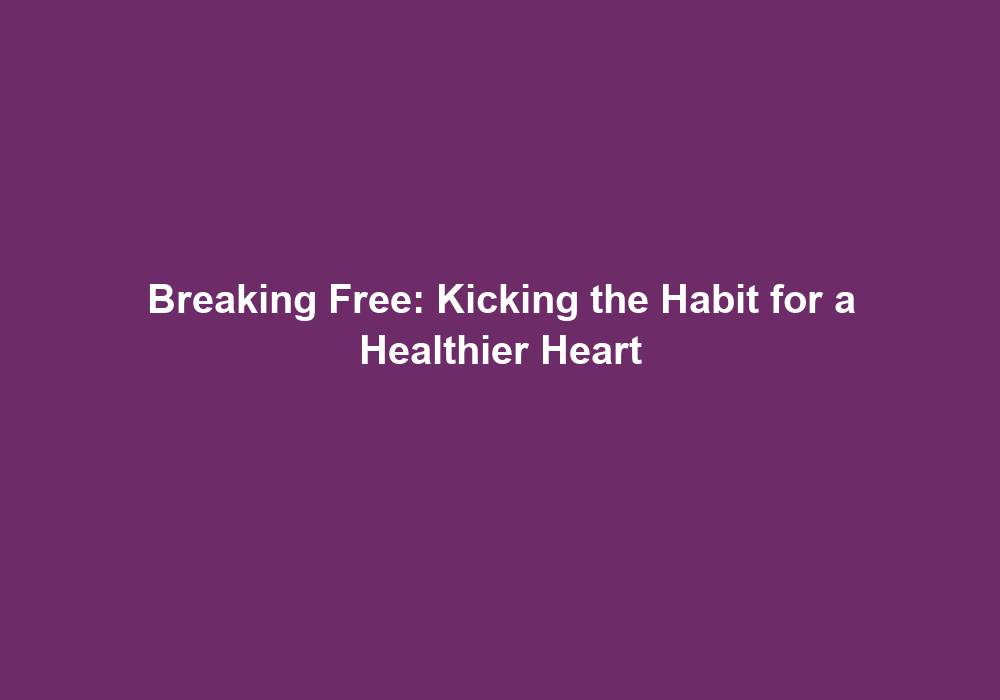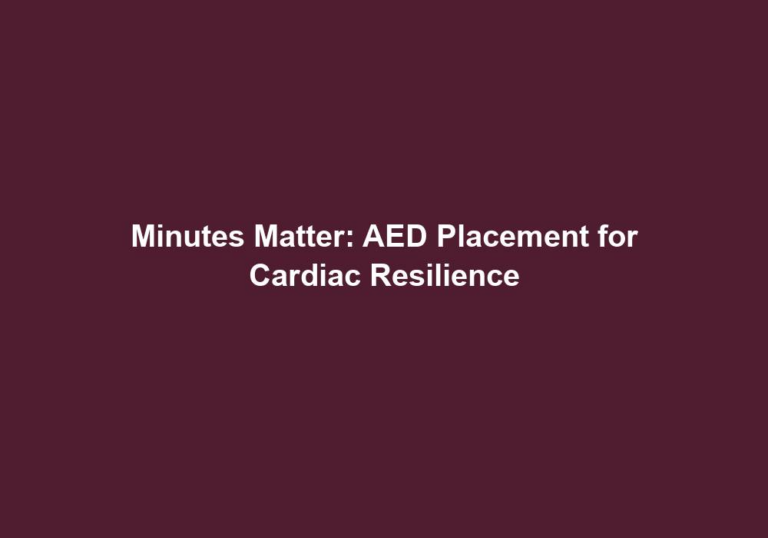Breaking Free: Kicking the Habit for a Healthier Heart
Cigarette smoking is a widespread habit that poses significant risks to our health, particularly our cardiovascular system. The harmful effects of smoking on the heart are well-documented, but the good news is that it’s never too late to quit and start on the journey towards a healthier heart. In this article, we will delve into the detrimental impact of smoking on heart health and provide valuable insights into how to break free from this addictive habit.
Understanding the Impact of Smoking on the Heart
-
Increased Risk of Heart Disease: Smoking is a major risk factor for various heart diseases, including coronary artery disease, heart attacks, and stroke. The chemicals present in tobacco smoke damage the lining of the blood vessels, leading to the formation of fatty deposits that restrict blood flow. This reduced blood flow to the heart can result in chest pain, heart attacks, and even sudden cardiac death.
- The chemicals in tobacco smoke, such as nicotine and carbon monoxide, contribute to the development of cardiovascular diseases by damaging the inner lining of blood vessels. This damage triggers an inflammatory response, leading to the accumulation of fatty deposits called plaques. These plaques restrict the flow of blood through the arteries, reducing oxygen and nutrient supply to the heart muscles.
- Additionally, smoking increases the risk of blood clots, which can block the narrowed arteries and further impede blood flow. This combination of reduced blood flow and increased clotting risk significantly raises the chances of heart attacks and strokes.
-
Hypertension: Smoking raises blood pressure levels, increasing the strain on the heart and blood vessels. Prolonged high blood pressure can weaken the heart muscles, leading to conditions such as heart failure and irregular heart rhythms.
- Smoking causes an immediate increase in blood pressure due to the nicotine’s stimulant effect on the nervous system. This temporary rise in blood pressure can become chronic with continued smoking, leading to hypertension or high blood pressure.
- Elevated blood pressure puts extra stress on the heart, making it work harder to pump blood throughout the body. Over time, this increased workload weakens the heart muscles and can lead to heart failure, a condition in which the heart cannot pump enough blood to meet the body’s needs.
-
Atherosclerosis: Smoking accelerates the development of atherosclerosis, a condition characterized by the buildup of plaque in the arteries. This plaque narrows the arteries and hinders blood flow, increasing the risk of heart attacks and strokes.
- Atherosclerosis is a complex process that involves the accumulation of cholesterol, fats, and other substances in the artery walls. Smoking contributes to the development of atherosclerosis by promoting the oxidation of LDL cholesterol, making it more likely to stick to the arterial walls and form plaques.
- As these plaques grow, they narrow the arteries, reducing blood flow to the heart. If a plaque ruptures or a blood clot forms on top of it, it can completely block the artery, leading to a heart attack or stroke.
-
Peripheral Artery Disease: Smoking also affects the blood vessels supplying the arms and legs, leading to peripheral artery disease. This condition reduces blood flow to the extremities and increases the risk of infections, poor wound healing, and even amputation.
- Smoking damages the blood vessels in the arms and legs, causing them to narrow and become less flexible. This narrowing restricts blood flow to the extremities, leading to symptoms such as leg pain, numbness, and weakness.
- Over time, the reduced blood flow can result in poor wound healing and an increased risk of infections. In severe cases, peripheral artery disease can lead to tissue death and the need for amputation.
Benefits of Quitting Smoking for Heart Health
Quitting smoking is one of the most significant steps you can take to improve your heart health. Here are the benefits you can reap by kicking the habit:
-
Reduced Risk of Heart Disease: Within just a few years of quitting smoking, your risk of heart disease significantly decreases. Your blood pressure and heart rate begin to normalize, and the risk of blood clots formation decreases.
- Within 2 years of quitting smoking, the risk of coronary artery disease, heart attacks, and strokes drops to nearly half that of a smoker. This reduction in risk continues to improve over time, leading to a significant improvement in heart health.
- As you quit smoking, your blood pressure and heart rate gradually return to normal levels. This decrease in blood pressure reduces the strain on your heart and lowers the risk of developing heart-related ailments.
- Quitting smoking also reduces the stickiness of platelets in the blood, which decreases the likelihood of blood clots forming and blocking the arteries.
-
Improved Blood Circulation: As you quit smoking, the function of your blood vessels improves, enhancing blood flow to all parts of your body, including the heart. This helps reduce the risk of atherosclerosis, heart attacks, and strokes.
- The improvement in blood vessel function after quitting smoking is attributed to the reduction in oxidative stress and inflammation caused by tobacco smoke. This improvement allows for better blood flow, ensuring an adequate supply of oxygen and nutrients to the heart and other organs.
- By quitting smoking, you also reduce the exposure to carbon monoxide, a toxic gas present in cigarette smoke that binds to hemoglobin and reduces its ability to carry oxygen. With improved oxygen-carrying capacity, the heart and other tissues receive the necessary oxygen for optimal functioning.
-
Lowered Risk of Aneurysms: Smoking weakens the walls of blood vessels, making them more susceptible to developing aneurysms. By quitting smoking, you reduce the risk of these life-threatening bulges in blood vessels.
- Aneurysms occur when the walls of blood vessels weaken and bulge outwards. Smoking damages the structural integrity of blood vessels, making them more prone to aneurysm formation.
- By quitting smoking, you allow the blood vessels to repair and strengthen, reducing the risk of aneurysms. This is especially important for critical arteries, such as those in the brain and aorta, where aneurysms can have severe consequences.
-
Decreased Risk of Peripheral Artery Disease: Quitting smoking not only reduces the risk of heart-related ailments but also helps improve blood circulation in the arms and legs. This decreases the likelihood of developing peripheral artery disease and its associated complications.
- Smoking-induced damage to the blood vessels in the arms and legs contributes to the development of peripheral artery disease. By quitting smoking, you allow the blood vessels to heal and improve their ability to supply blood to the extremities.
- Improved blood flow to the arms and legs reduces the risk of complications such as infections, poor wound healing, and amputation. It also improves mobility and overall quality of life.
Strategies to Quit Smoking and Improve Heart Health
-
Set a Quit Date: Choose a specific date to quit smoking entirely. This will help you mentally prepare and create a sense of commitment towards your goal.
- Setting a quit date provides a clear target and helps you focus your efforts on preparing for a smoke-free life. It allows you to mentally prepare for the challenges that may arise during the quitting process.
- Make sure to choose a date that is realistic and convenient for you. Consider marking it on the calendar and sharing it with your close friends and family for added accountability and support.
-
Identify Triggers: Be aware of situations, activities, or emotions that trigger your smoking habit. By identifying these triggers, you can develop strategies to avoid or cope with them effectively.
- Triggers can vary from person to person, but common ones include stress, social situations, and certain activities or locations. Pay attention to the circumstances that make you crave a cigarette and try to find healthier alternatives or coping mechanisms.
- For example, if you tend to smoke when feeling stressed, consider engaging in relaxation techniques such as deep breathing exercises, meditation, or yoga. Finding healthier ways to manage stress can help break the association between smoking and stress relief.
-
Seek Support: Inform your friends, family, and coworkers about your decision to quit smoking. Their support and encouragement can significantly contribute to your success. Additionally, consider joining support groups or seeking professional help to increase your chances of quitting successfully.
- Building a strong support system is crucial when quitting smoking. Informing your loved ones about your decision to quit can provide emotional support and understanding during challenging times.
- Joining support groups or seeking professional help, such as counseling or behavioral therapy, can provide additional guidance and resources to help you quit successfully. These resources offer strategies, coping mechanisms, and personalized support tailored to your specific needs.
-
Explore Nicotine Replacement Therapies: Nicotine replacement therapies, such as nicotine gum or patches, can help ease withdrawal symptoms and cravings. Consult with a healthcare professional to determine the most suitable option for you.
- Nicotine replacement therapies work by supplying a controlled dose of nicotine to the body, reducing the intensity of withdrawal symptoms and cravings. They can be effective in managing the physical addiction to nicotine during the quitting process.
- Consult with a healthcare professional to discuss the different nicotine replacement options available and determine the most suitable one for your needs. They can provide guidance on proper usage, dosage, and potential side effects.
-
Adopt Healthy Coping Mechanisms: Find alternative ways to manage stress and negative emotions without turning to cigarettes. Engaging in physical activity, practicing relaxation techniques, or pursuing hobbies can serve as healthy distractions and provide a sense of fulfillment.
- Smoking often becomes a coping mechanism for dealing with stress, anxiety, or negative emotions. Finding healthier alternatives can help you break the habit and improve your overall well-being.
- Engaging in regular physical activity, such as walking, jogging, or cycling, can help reduce stress and improve mood by releasing endorphins, the body’s natural mood boosters.
- Practicing relaxation techniques, such as deep breathing exercises, progressive muscle relaxation, or mindfulness meditation, can help calm the mind and reduce stress levels.
- Pursuing hobbies or activities that bring you joy and fulfillment, such as painting, gardening, or playing a musical instrument, can provide a healthy outlet for stress and serve as a distraction from cravings.
-
Stay Persistent and Positive: Quitting smoking is a challenging process, and setbacks may occur. It’s important to remain persistent and maintain a positive mindset. Celebrate small victories along the way and remind yourself of the immense benefits you are gaining for your heart health.
- Quitting smoking is a journey that requires determination and perseverance. It’s normal to experience cravings or slip-ups, but don’t let them discourage you. Instead, view them as learning opportunities and reminders of why you decided to quit in the first place.
- Celebrate each smoke-free day and acknowledge the progress you’ve made. Remind yourself of the numerous benefits you are gaining for your heart health, such as improved circulation, reduced risk of heart disease, and a brighter future.
Conclusion
Breaking free from the clutches of smoking is a key step towards achieving a healthier heart. By understanding the detrimental impact of smoking on heart health and implementing effective strategies to quit, you can significantly reduce your risk of heart disease, improve blood circulation, and enhance overall cardiovascular well-being. Remember, every smoke-free day brings you closer to a healthier heart and a brighter future.







